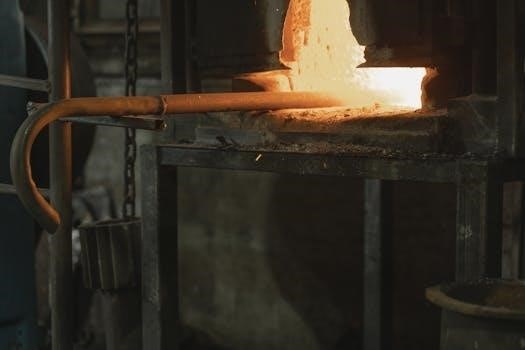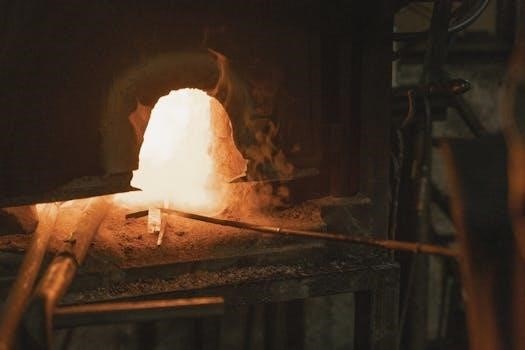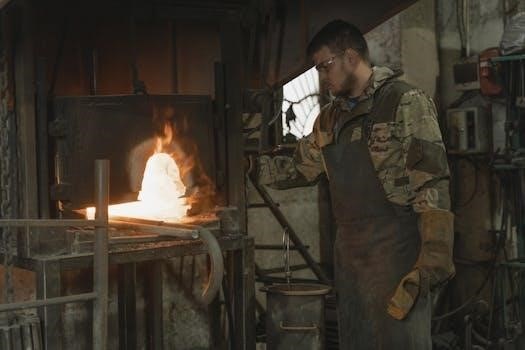Comfortmaker Furnace Manual PDF⁚ A Comprehensive Guide
This guide provides a structured overview of Comfortmaker furnace manuals in PDF format. It aims to assist homeowners and technicians in locating and understanding the essential documentation for their furnace models, ensuring safe and efficient operation.
Comfortmaker furnaces are designed for durability, energy efficiency, and reliable home comfort. These systems use natural gas combined with efficient blower motors to provide warmth throughout the cold seasons. Comfortmaker offers a range of gas furnaces, from premium Ion series with modulating gas valves to budget-friendly Performance models. These furnaces often include features like variable-speed blowers and two-stage operation for enhanced temperature control.
The Ion series can be paired with the Ion Black System Control for maximum comfort control. Models range from ultra-low NOx furnaces designed for California to ENERGY STAR qualified units. Features like dual-fuel capabilities and compatibility with heat pumps offer energy-saving options. Comfortmaker furnaces come in premium, standard, value, and select series, designed to meet a variety of needs and budgets, all designed to provide quality and efficiency.
Understanding Your Comfortmaker Furnace Model
Identifying your specific Comfortmaker furnace model is the first crucial step in accessing the correct manual. The model number is typically located on a rating plate affixed to the furnace. This plate often contains other important information, such as the unit’s BTU input, electrical requirements, and manufacturing date.
Once you have the model number, you can search online for the corresponding Comfortmaker furnace manual PDF. Comfortmaker manuals provide detailed information on the furnace’s specifications, installation procedures, operating instructions, and troubleshooting tips. They also include safety precautions and maintenance guidelines.
Understanding your model helps you determine compatibility with other systems and components, such as thermostats and heat pumps. Manuals also detail specific features like variable-speed blowers, two-stage operation, or ultra-low NOx emissions for California models. Proper identification ensures you follow the right procedures for your specific unit’s configuration and performance characteristics to maintain your comfort throughout the year.

Key Components and Their Functions
Understanding the key components of your Comfortmaker furnace is crucial for effective troubleshooting and maintenance. This section details the essential parts and explains their respective functions within the heating system.
Control Board and Manual Reset
The control board serves as the central processing unit for your Comfortmaker furnace, managing its operational sequence and safety features. It monitors various sensors, including the flame sensor and limit switches, to ensure safe and efficient heating. If the furnace experiences a fault, the control board may shut down the system, requiring a manual reset.
A manual reset is often necessary after a lockout caused by issues like overheating or flame failure. The Comfortmaker furnace manual PDF provides specific instructions for performing a manual reset, typically involving locating the reset button on the control board or cycling the power to the furnace. Always consult the manual for the exact procedure to avoid damaging the system.
Understanding the control board’s functions and the manual reset process is vital for diagnosing common furnace problems and restoring operation. Proper maintenance and adherence to the manual’s guidelines can prevent frequent resets and ensure the longevity of your Comfortmaker furnace.
Rollout Switch and Flame Sensor
The rollout switch and flame sensor are crucial safety components in your Comfortmaker furnace. The rollout switch, typically located near the burners, detects excessive heat or flames escaping from the combustion chamber. If a rollout condition occurs, the switch trips, shutting down the gas supply to prevent a potential fire hazard. Refer to your Comfortmaker furnace manual PDF for specific location and reset instructions for the rollout switch on your model.
The flame sensor, on the other hand, verifies the presence of a stable flame during the heating cycle. It’s usually a small metallic rod positioned near the burner. If the flame sensor doesn’t detect a flame, it signals the control board to shut off the gas valve, preventing unburned gas from accumulating. A dirty or faulty flame sensor is a common cause of furnace malfunction.
Your Comfortmaker furnace manual PDF will provide guidance on troubleshooting flame sensor issues, including cleaning procedures and testing methods. Understanding the function of both the rollout switch and flame sensor is essential for ensuring safe and reliable furnace operation.
Gas Burner and Hot Surface Igniter
The gas burner and hot surface igniter are fundamental to the heating process in your Comfortmaker furnace; The gas burner is responsible for mixing gas and air in the correct proportions to create a controlled and efficient flame. Different Comfortmaker furnace models may utilize various burner designs, each optimized for specific performance characteristics. Your Comfortmaker furnace manual PDF will contain detailed diagrams and specifications for the gas burner assembly in your unit.
The hot surface igniter (HSI) is an electrical component that heats up to a high temperature to ignite the gas-air mixture. Unlike older pilot light systems, the HSI only operates when heat is needed, making it more energy-efficient. Over time, HSIs can become brittle and fail.
Consult your Comfortmaker furnace manual PDF for instructions on safely inspecting the gas burner for clogs or damage, as well as guidance on replacing the hot surface igniter. Proper maintenance of these components is crucial for ensuring reliable and efficient heating. Remember to always disconnect power to the furnace before performing any inspection or maintenance.
Inducer Motor Assembly and Blower Motor
The inducer motor assembly and blower motor are vital components for the proper functioning of your Comfortmaker furnace. The inducer motor, also known as a draft inducer, plays a crucial role in venting combustion gases safely outside your home. It creates negative pressure within the heat exchanger, ensuring that these gases do not leak into your living space. The Comfortmaker furnace manual PDF will outline the specific maintenance and troubleshooting steps for your inducer motor model.
The blower motor, on the other hand, circulates heated air throughout your home via the ductwork. It pushes air across the heat exchanger, where the air is warmed, and then distributes it to different rooms. Comfortmaker furnaces often use variable-speed blower motors for enhanced comfort and energy efficiency.
Your Comfortmaker furnace manual PDF will contain diagrams and instructions for inspecting and maintaining both the inducer and blower motors. This may include cleaning the blower wheel, lubricating bearings, and checking for proper voltage. A malfunctioning inducer or blower motor can significantly impact furnace performance and safety, so refer to your manual for proper care.
Blower Door Safety Switch
The blower door safety switch is a critical safety feature integrated into Comfortmaker furnaces. This switch is designed to prevent the furnace from operating when the blower door is open or improperly secured. Its primary function is to protect individuals from potential hazards associated with exposed moving parts, high-voltage components, and direct contact with the blower assembly while the furnace is running.
The Comfortmaker furnace manual PDF provides specific instructions on how to locate, inspect, and test the blower door safety switch. The manual will detail the correct positioning of the blower door and how to ensure the switch is properly engaged. In most cases, the switch is a simple mechanical or electrical device that interrupts the power supply to the furnace’s control system when the blower door is not in its correct, closed position.
If the switch malfunctions, the furnace might not start, or it could potentially operate with the blower door open, negating the safety benefits. The manual typically includes troubleshooting steps for a faulty switch, which might involve checking the wiring connections, testing the switch with a multimeter, or replacing the switch altogether. Always consult your Comfortmaker furnace manual PDF for model-specific guidance.

Safety Precautions and Important Information
Prioritize safety when operating your Comfortmaker furnace. This section emphasizes crucial guidelines found in the manual PDF. Always understand warnings, maintenance, and emergency procedures to ensure safe and efficient furnace operation.
Dos and Don’ts for Furnace Operation
Operating your Comfortmaker furnace safely and efficiently requires following specific guidelines. First, DO thoroughly read and understand your furnace manual. This ensures you’re aware of its features and safety protocols. DO schedule annual inspections by qualified technicians to maintain optimal performance and prevent potential hazards like carbon monoxide leaks. DO ensure proper ventilation around the furnace, avoiding any obstructions that could hinder airflow. DO promptly replace air filters to maintain efficiency and air quality.
Conversely, DON’T attempt repairs unless you are a trained professional. Incorrect repairs can lead to dangerous situations. DON’T ignore unusual noises, smells, or performance issues; contact a qualified technician immediately. DON’T store flammable materials near the furnace. DON’T block or cover any vents or registers. DON’T tamper with safety devices like rollout switches or flame sensors. Adhering to these dos and don’ts will maximize the lifespan of your Comfortmaker furnace and ensure your home’s safety and comfort. Remember to always consult your specific model’s manual for detailed instructions.

Troubleshooting Common Issues
Addressing problems promptly is crucial to maintaining your Comfortmaker furnace’s performance. One common issue is the furnace failing to ignite. Check the gas supply, pilot light (if applicable), and igniter. If the igniter isn’t glowing, it may need replacement. Another frequent concern is insufficient heating. Ensure the thermostat is set correctly and the air filter is clean. Blocked vents can also restrict airflow.
Unusual noises, like banging or rattling, often indicate mechanical problems. Inspect the blower motor and fan for loose parts or obstructions. A malfunctioning blower motor can also cause the furnace to overheat. If the furnace cycles on and off frequently, this could signal a problem with the flame sensor or a clogged burner. Always consult your Comfortmaker furnace manual PDF for specific troubleshooting steps related to your model. For complex issues, seeking professional assistance from a qualified HVAC technician is highly recommended to prevent further damage or safety hazards. Remember safety first.

Finding the Right Comfortmaker Manual PDF
Locating the correct Comfortmaker furnace manual PDF is essential for proper maintenance and troubleshooting. Start by identifying your furnace’s model number, usually found on a data plate inside the unit’s control panel or on the exterior. Once you have the model number, visit the official Comfortmaker website, where a searchable database of manuals is often available. If the manufacturer’s website doesn’t have the manual, try searching online using the model number and keywords like “Comfortmaker furnace manual PDF;”
Numerous third-party websites host appliance manuals, but exercise caution and only download from reputable sources to avoid malware or incorrect information. Online forums and HVAC communities can also be valuable resources. Members may have already uploaded the manual you need or can provide direct links. Remember to verify the manual’s version and applicability to your specific Comfortmaker furnace model before relying on it for repairs or adjustments. Also, consider checking user manuals simplified or ManualsLib.
Annual Inspection and Maintenance
Scheduling an annual inspection and performing regular maintenance are crucial for extending the lifespan and ensuring the efficient operation of your Comfortmaker furnace. A professional HVAC technician can conduct a thorough inspection, checking for gas leaks, proper combustion, and any signs of wear or damage to key components such as the gas burner, heat exchanger, and blower motor; They can also verify that the furnace is equipped with the correct main burner orifices.
Homeowners can perform basic maintenance tasks, such as replacing the air filter every one to three months to maintain proper airflow and efficiency. Regularly inspect the venting system to ensure it’s free from obstructions and properly sealed. It’s also wise to check the flame sensor and clean it if necessary, as a dirty sensor can cause the furnace to malfunction. Consult your Comfortmaker furnace manual PDF for specific maintenance recommendations tailored to your model, and always prioritize safety when working with gas appliances.
